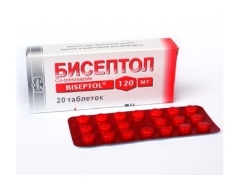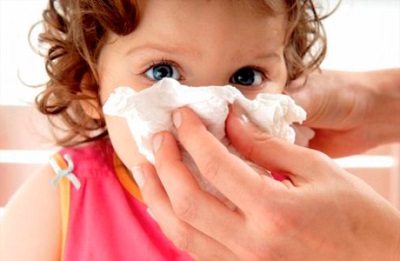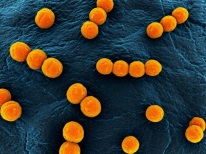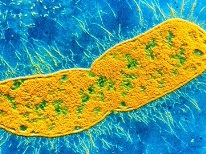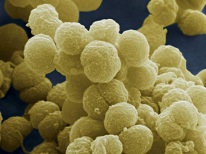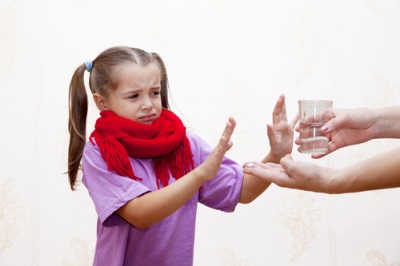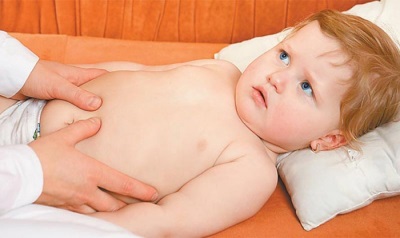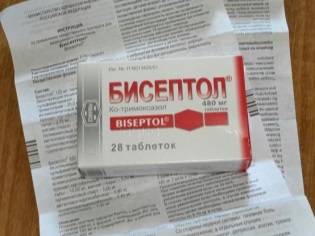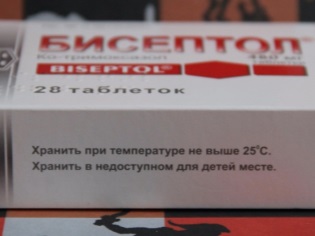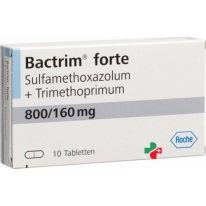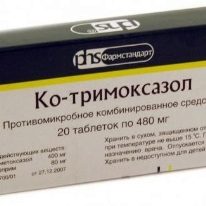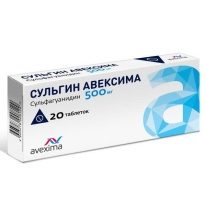Tablets "Biseptol": instructions for use for children
Among sulfa drugs the most popular can be called Biseptol. This drug is produced in suspensions, which can be given even to the smallest children. In addition, Biseptol is available in tablets. Is it allowed to give children this dosage form and in what dosage is it used?
Release form
Biseptol tablets are distinguished by a round flat shape, white (sometimes yellow) color, and the presence of risks and Bs engraving. They are packaged in blisters of 20 pieces and sold for 1 blister in a pack.
Composition
The substance that provides Biseptolu therapeutic effect, called co-trimoxazole. This name combines two active compounds, the ratio of which in one tablet is 5 to 1. Depending on the number of such active substances, the drug is represented in two dosages:
- 120 mg tablets, in which there is 100 mg of sulfamethoxazole, supplemented with 20 mg of trimethoprim.
- 480 mg tablets, of which the patient receives sulfamethoxazole in the amount of 400 mg, and trimethoprim in the dose of 80 mg.
To keep the preparation solid and the tablet kept in shape, talc, Mg stearate, propyl and methyl parahydroxy benzoate, potato starch, propylene glycol and polyvinyl alcohol are added to the composition.
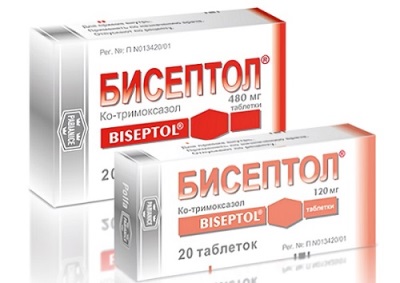
Operating principle
The active substances in the composition of Biseptol have a bactericidal effect. They affect the synthesis of proteins in bacterial cells, disrupting it, causing microbes to die. The drug is active when infected with Escherichia coli, enterococci, Klebsiella, Salmonella, pneumococcus, Proteus, shigella, pneumocystis and many other bacteria. In relation to pseudomonads, mycobacteria, leptospira, viruses, treponema and some other microorganisms, Biseptol is ineffective.
Indications
Biseptol helps with infections caused by pathogens that are sensitive to it. It is prescribed for:
- Purulent otitis.
- Sinusitis.
- Typhoid fever.
- Cholera.
- Salmonellosis.
- Brucellosis.
- Bronchitis
- Bacterial diarrhea.
- Pneumocystis.
- Typhoid fever.
- Scarlet fever.
- Angina
- Pharyngitis.
- Gonorrhea.
- Whooping cough.
- Laryngitis
- Pneumonia.
- Bronchiectasis.
- Peritonitis
- Cholangitis
- Osteomyelitis.
- Abscesses of the skin.
- Furunculosis
- Urethritis
- Orchite.
- Cystitis and many other infections.
Dr. Komarovsky devoted to infectious diseases in children one of his programs:
At what age is it allowed to take?
The instructions for use of the Biseptol tablet form include information that the product is recommended for children over three years old. If you want to prescribe a medicine for babies who have not yet turned 3 years old, use the suspension. It can be given from 2 months of age.
Contraindications
The use of Biseptol is prohibited:
- If a child has an intolerance to such a drug or other sulfanilamide drugs.
- If the analyzes of a small patient showed renal failure.
- If a child has a damaged liver and its work is severely impaired.
- If deficiency of glucose 6 phosphate dehydrogenase is found.
- If the blood test revealed agranulocytosis, aplastic anemia or leukopenia.
The use of the drug with caution implies that the child has an allergic disease, thyroid disease, lack of vitamins B9 and B12 or porphyria.
Side effects
A child’s body often reacts to Biseptal’s treatment with an allergy or disorder of the digestive tract. In addition, the drug may cause:
- The oppression of blood.
- Dizziness, apathetic or depressive state, convulsions, headaches.
- Shortness of breath and cough.
- Impaired renal function.
- Pain in the joints or muscles.
Instructions for use and dosage
Tablets should be drunk after a meal, washed down with water in large enough quantities. The dosage is best determined individually on the basis of the clinical picture, the condition of the child, the sensitivity of the pathogen and other factors. Biseptol tablets are usually given in a single dose:
|
3-5 years old child |
2 tablets of 120 mg (total 240 mg of active compound) |
|
6-12 years old child |
4 tablets of 120 mg or 1 tablet of 480 mg (total 480 mg of the active substance) |
In this single dose, Biseptol must be taken twice a day., and the interval between receptions should be 12 hours.
The duration of use is determined depending on the pathology. The drug is prescribed for at least 5 days, and when the symptoms of infection pass, it should be taken for another two days. The average duration of treatment with Biseptol is from 5 to 14 days. If the infection is severe, single doses may be increased by 30-50%.
Overdose
If you take more pills than prescribed by a doctor, the child will have headache, nausea, abdominal pain, drowsiness, fever, and other negative symptoms. Prolonged excess dosage leads to anemia, leukopenia, jaundice and thrombocytopenia.
Food interactions with other drugs
- Biseptol tablets should not be taken with milk, as this will reduce their effect.
- Before taking the drug should not eat foods that are quickly absorbed and excreted from the intestines, such as baking or dried fruit.
- At the time of treatment in the patient's diet, it is desirable to limit fatty animal products, as well as peas, cabbage, carrots, beans and tomatoes.
- Biseptol enhances the therapeutic effect of the use of indirect anticoagulants, hypoglycemic drugs, phenytoin and methotrexate.
- Co-administration with diuretic drugs will increase the risk of thrombocytopenia.
- The drug should not be used with aspirin or drugs that can inhibit blood formation.
Terms of sale
To purchase the Biseptol tablet form, you must submit a prescription from a doctor. The average price for a pack of tablets with 120 mg of active compound is 30 rubles.
Storage conditions and shelf life
Biseptol tablets should be stored away from moisture and sunlight, at temperatures below +25 degrees. To the drug should not be free access in children. The shelf life of this form of medication is 5 years.
Reviews
On the use of Biseptol tablets in children, mothers and doctors respond differently. Someone notes that the medicine has helped cure bronchitis, otitis, cystitis, or another infection, and someone complains about its ineffectiveness. In addition, in negative reviews, parents mention that many children have difficulty swallowing pills and react to them with a rash or nausea.
Analogs
As a replacement for preformed Biseptol can be used:
- Bactrim Forte. Such a drug is a complete analogue, that is, it includes the same active compounds. It is also produced in tablets, but because of the high dosage, this agent is prescribed from the age of 12.
- Co-trimoxazole. This analogue of Biseptolum is produced in granules, suspensions and tablets with several dosages.It can be given with the same indications as Biseptol.
- Bi-septin. Such a preparation is represented by tablets containing 120 or 480 mg of active compounds. The medicine with a lower dosage can be used from 1 year.
Also, instead of Biseptol, you can use other drugs of the sulfonamide group, for example:
- Sulgin. The active substance of this tool is represented by sulfaguanidine. The drug is produced in tablet form and is used in the treatment of children over 3 years old.
- Sulfadimethoxine. This medicine is an antimicrobial pill, prescribed to children over 2 years old.
- Sulfadimezin. Such tablets are used in the treatment of children who are 3 years old.
